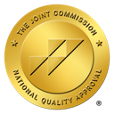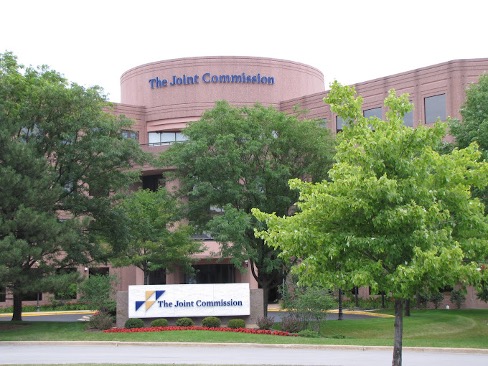A Complete Guide to Joint Commission Accreditation: Standards & Certification

A Complete Guide to Joint Commission Accreditation
Getting an accreditation from the Joint Commission is more than checking off a box—it’s a signal to your patients and staff that you take patient safety and care quality very seriously. According to their website, “Joint Commission accreditation is the objective evaluation process of organizational compliance to performance standards designed to inspire and improve quality and safety for those they serve.” Accreditation is a hallmark of excellence, signifying an unwavering commitment to meeting rigorous standards and elevating the bar for healthcare provision. And getting an accreditation in and of itself can bring several great benefits—especially through enhanced patient safety, as accreditation fosters a culture of continuous improvement and adherence to best practices, mitigating risks and safeguarding patients’ well-being.

There’s also a beneficial impact to your quality of care. Through meticulous evaluation and adherence to standards across delivery workflows, organizations refine their processes and ensure that patients receive the highest caliber of treatment and service.
Specifically, accreditation serves as a catalyst for operational excellence, spurring efficiency gains, optimizing resource utilization, and bolstering overall effectiveness. Joint accreditation for healthcare organizations delivers a competitive edge, instilling confidence among patients, stakeholders, and the broader community alike.
Just remember: the road to accreditation is a tough one. It demands unwavering dedication, meticulous preparation, and a steadfast commitment to excellence at every turn. Sound a little daunting? It is, but we’re here to help with some tips and insights into getting your accreditation.
What is the Joint Commission and Why is it Important?
The Joint Commission, formerly known as the Joint Commission on Accreditation of Healthcare Organizations (JCAHO), was established in 1951. It emerged in response to a pressing need for standardized measures to ensure the quality of care provided by healthcare organizations across the nation.

Initially focused on evaluating and accrediting hospitals, the Joint Commission soon expanded its purview to encompass a wide array of healthcare settings. Throughout its history, the Joint Commission has played a pivotal role in setting the bar for healthcare quality and safety through the development and refinement of rigorous standards and accreditation processes. Guided by a commitment to continuous improvement and evidence-based practices, it has remained at the forefront of efforts to enhance patient outcomes, mitigate risks, and foster a culture of excellence within healthcare organizations.
What is Joint Commission Accreditation?
The standards and requirements set forth by the Joint Commission are extensive and multifaceted, reflecting a holistic approach to evaluating organizational performance and patient outcomes. These standards cover a broad spectrum of areas, including:
- Patient care and treatment processes
- Infection prevention and control
- Medication management
- Patient rights and responsibilities
- Leadership and governance
- Performance improvement and patient safety initiatives
- Staff qualifications and competence
- Facility safety and security
To achieve accreditation, healthcare organizations must demonstrate compliance with these standards through documentation, site visits, interviews, and performance data analysis. Accreditation is not merely a one-time achievement; rather, it’s an ongoing commitment to continuous improvement and adherence to best practices.
Key Components of Joint Commission Accreditation
There are four major components to accreditation:
- Standardized Performance Measures: Standardized performance measures serve as benchmarks for evaluating the quality and effectiveness of care provided by healthcare organizations. These measures encompass clinical outcomes, patient experiences, and adherence to best practices. By collecting and analyzing data on performance measures, organizations can assess their performance, identify areas for improvement, and track progress over time. Compliance with standardized performance measures is essential for demonstrating accountability, transparency, and a commitment to delivering high-quality care.
- Patient Safety Concerns: Patient safety is a paramount concern for healthcare organizations, and addressing patient safety concerns is a central component of Joint Commission accreditation. This includes implementing protocols and initiatives to prevent medical errors, reduce adverse events, and enhance the overall safety of care delivery. Organizations are evaluated on their adherence to evidence-based practices for infection control, medication safety, fall prevention, and other critical areas of patient safety. By prioritizing patient safety, organizations can minimize harm, improve outcomes, and foster a culture of safety throughout the organization.
- Healthcare Equity: Healthcare equity encompasses the fair and equitable provision of healthcare services to all individuals, regardless of race, ethnicity, socioeconomic status, or other demographic factors. The Joint Commission recognizes the importance of addressing healthcare disparities and promoting equity in care delivery. Accredited organizations are expected to implement strategies to reduce disparities, promote culturally competent care, and ensure that all patients have access to high-quality, equitable healthcare services. By prioritizing healthcare equity, organizations can improve access to care, reduce disparities in health outcomes, and enhance patient satisfaction and trust.
- Workplace Violence Prevention: Workplace violence prevention is an essential component of ensuring a safe and respectful work environment for healthcare staff, patients, and visitors. The Joint Commission requires accredited organizations to develop and implement policies, procedures, and training programs to prevent and address workplace violence incidents. This includes strategies for identifying and mitigating risk factors, de-escalating potentially violent situations, and supporting staff who have experienced violence.
Joint Commission Standards and Certification
The Joint Commission sets rigorous standards and certification requirements that healthcare organizations must meet to achieve accreditation. These standards cover a broad range of areas critical to delivering high-quality, safe, and effective care, and include:
- Patient rights and responsibilities
- Provision of care, treatment, and services
- Infection prevention and control
- Medication management
- Performance improvement
- Patient and family education
- Leadership and governance
The Accreditation Process
The accreditation process involves several steps, careful planning, and adherence to specific standards set by the Joint Commission. Here’s a breakdown of the typical process and some of the requirements for joint commission accreditation:
- Preparation and Self-Assessment:
- Assess Readiness: Evaluate the organization’s current practices against Joint Commission standards.
- Identify Gaps: Determine areas where improvements are needed to meet the standards.
- Formulate Action Plan: Develop a strategy to address identified gaps and prepare for accreditation.
- Application and Documentation:
- Submit Application: Apply for accreditation with the Joint Commission.
- Compile Documentation: Gather and organize necessary documents, policies, procedures, and evidence of compliance with standards.
- Onsite Survey:
- Scheduled Visit: The Joint Commission sends surveyors for an onsite evaluation.
- Survey Process: Surveyors conduct interviews, observe practices, and review documentation to assess compliance with standards.
- Feedback: Receive feedback and recommendations during the onsite visit.
- Post-Survey Follow-Up:
- Address Findings: Implement corrective actions based on survey findings and recommendations.
- Submit Follow-Up Reports: Provide evidence of corrections made to address any identified deficiencies.
- Accreditation Decision:
- Review Process: The Joint Commission reviews the survey findings and supporting documentation.
- Accreditation Decision: The organization is notified of the accreditation decision.
The duration of the accreditation process can vary depending on your organization’s readiness and the complexity of required improvements. Plan for several months to a year for preparation, submission, survey, and follow-up activities.
Benefits of Joint Commission Accreditation
Achieving Joint Commission accreditation offers several key benefits. First, it significantly improves patient safety by ensuring healthcare organizations adhere to rigorous standards that prioritize quality care and safety protocols. This leads to better outcomes and reduced risks for patients.
Second, accreditation enhances organizational performance by promoting a culture of continuous improvement and accountability. It encourages healthcare facilities to evaluate and optimize their processes, resulting in more efficient operations and higher standards of care delivery.
Accreditation increases credibility. It demonstrates a commitment to excellence in healthcare, which boosts public trust and confidence in the organization. Patients are more likely to choose accredited facilities, leading to improved patient satisfaction and loyalty.
Joint Commission FAQs
Beyond what we’ve already discussed, we wanted to make space for a few additional insights based on common questions:
Is there anything behavioral health organizations need to do differently? Yes, behavioral health facilities do have some different things to consider getting accredited. Behavioral health organizations are assessed against specific standards covering areas such as clinical assessment, treatment planning, suicide prevention, medication management, crisis intervention, and continuity of care. There’s an emphasis on patient-centered care for behavioral health, as well as additional safety and environment standards. If you’re a behavioral health facility trying to get accredited, make sure you have a strong and effective behavioral health EMR and a behavioral health CRM in place. These aren’t necessary, but they can help make the process smoother.
How do we know if we’re ready for accreditation? Conduct a self-assessment against Joint Commission standards. Identify areas needing improvement and develop an action plan to address gaps.
What are the key steps in the accreditation process? The process involves application submission, onsite survey by Joint Commission surveyors, addressing survey findings, and awaiting accreditation decision.
How long does accreditation last? Accreditation is typically valid for three years, subject to ongoing monitoring and periodic reviews.
What’s the difference between Joint Commission and JCAHO? The Joint Commission, now officially known as simply “The Joint Commission,” is an independent, not-for-profit organization that accredits and certifies healthcare organizations and programs in the United States. JCAHO is the former name for what is now known as The Joint Commission.
Can a hospital or healthcare facility operate without Joint Commission accreditation? Yes, a hospital or healthcare facility can technically operate without Joint Commission accreditation.
What accreditation do most hospitals use? The Joint Commission is the most used accreditation organization, but there are other accrediting bodies in the United States, such as the Healthcare Facilities Accreditation Program (HFAP) and DNV GL Healthcare, which also provide accreditation services for healthcare facilities.
Who oversees The Joint Commission? The Joint Commission is overseen by its own Board of Commissioners, which is responsible for governance, oversight, and strategic direction of the organization. The Board of Commissioners comprises individuals with diverse backgrounds and expertise in healthcare, patient advocacy, quality improvement, and related fields.
Choosing the Right Accreditation Path
Healthcare organizations have different paths to achieve Joint Commission accreditation, each tailored to their unique circumstances and goals. To know which one is ideal for your organization, you should know what paths are available. The main paths include:
- Regular Accreditation Process: This traditional path involves a comprehensive review of the organization’s compliance with Joint Commission standards. It’s suitable for organizations seeking initial accreditation or renewal and involves a thorough assessment and onsite survey.
- Advanced Certification Programs: The Joint Commission offers specialized certification programs in areas like stroke care, heart failure management, and palliative care. Organizations can pursue these programs to demonstrate excellence in specific clinical services.
- Collaborative Accreditation Programs: Collaborative accreditation programs, such as the Academic Medical Center Hospital Accreditation Program, are designed for academic medical centers and teaching hospitals. They emphasize academic excellence alongside quality patient care.
Joint Commission Accreditation Resources
By this point, you may be feeling overwhelmed. But don’t fret! There are some excellent resources available to help organizations on their accreditation journeys. They provide up-to-date information, practical tools, and expert guidance to help organizations navigate complex accreditation requirements effectively.
- Accreditation Resource Center (ARC): The Accreditation Resource Center (ARC) is an online platform provided by the Joint Commission. It offers a wealth of tools, webinars, FAQs, and resources to guide organizations through the accreditation process. The ARC helps with standards interpretation, self-assessment, and compliance strategies.
- Joint Commission Officers and Consultants: The Joint Commission assigns officers and consultants to assist organizations throughout the accreditation journey. These experts provide guidance, conduct mock surveys, and offer tailored support to address specific needs and challenges.
- Joint Commission Journal on Quality and Patient Safety:The Joint Commission Journal is a peer-reviewed publication that showcases best practices, research, and case studies related to quality improvement and patient safety. It offers valuable insights and evidence-based strategies for achieving and maintaining accreditation.
While getting an accreditation is a challenge, it’s also an accomplishment. Organizations that embrace the accreditation process wholeheartedly will find rewards are plentiful, not merely in terms of recognition but in the profound impact on the success and sustainability of their mission. Joint Commission accreditation can have broader implications for healthcare organizations, including higher rates of reimbursement or increased network participation by many payers across the continuum of care —which can be a boon for behavioral health revenue cycle management, participation in healthcare networks and partnerships, and attracting patients who value accreditation as a marker of quality and safety. Overall, meeting Joint Commission standards is not only a regulatory requirement but also a strategic imperative for healthcare organizations seeking to excel in today’s complex and competitive healthcare landscape.
Recent Posts
Rely on Kipu to keep you ahead of change.
Subscribe to Kipu for behavioral health news, updates, community celebration, and product announcements.



